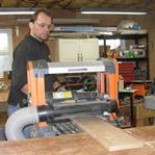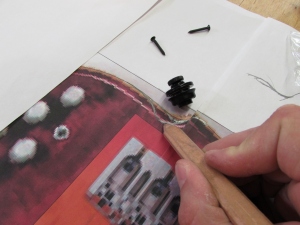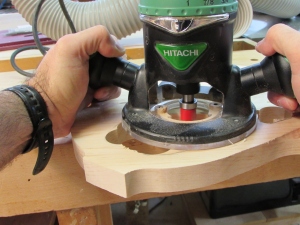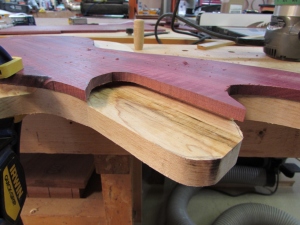Purpleheart & maple bass guitar – day 2
My last couple of weekends have been busy with graduations, so I haven’t been able to work on the bass guitar at all. I decided to blow off work today and spend some time on the project.
I have been slowly accumulating all the components that I will need for this build. I laid them up against the full-scale image, that I had and realized that some revisions would be required.
I laid everything out on the print to verify size and locations.
When I was satisfied, I cut out the pattern and taped it to the maple slab, that I glued up last week.
I also sketched in some lightning holes, then transferred the outlines to the maple.
Before I cut out the body shape, I want to cut out the neck pocket. This is easier to do now, because there won’t be any place to rest the router if I cut away the excess. I am only cutting down about 1/4″, because I will be adding a top to it. I don’t want to cut too deep and have to shim it later. I inserted a 1/4″ spiral up-cut bit into the router and started cutting.
After a quick test fit, I moved on to the next problem. The guitar, in the picture, has the smaller horn recessed about 1/4″. It also curves up where it will meet the body. I cut around the horn, on the band saw, but I didn’t remove the waste. This is because, again I will need the flat area to support the router, but also because I will lose my marks after I route away the top 1/4″.
I recently picked up a bowl cutting bit, with a 1/4″ radius. I decided to use this bit to cut the relief and the radius, that I wanted.
It turned out pretty good, so I drew back in the last bit of the horn’s curve.
I finished cutting the outside of the body, then cleaned up the edges on the spindle sander.
I switched to a smaller radius spindle for the tight spots.
To hog out the material in the lightning holes, I used several different size forstner bits.
I tried using my large 1/2″ straight bit to clean up the holes, but it grabbed a bit of the grain, in the control pocket, and cracked a piece.
I switched to my smaller spiral bit to finish the clean-up.
I applied a bit of glue to the cracked piece and pressed it back into place.
A little more time on the spindle sander, and the holes were all smoothed out.
I flipped the body over and traced the outline onto the purpleheart.
I carefully marked the recessed edge near the smaller horn, on both sides. Then I connected the two lines using a straight edge.
I cut out the purpleheart top piece, then used my awl to mark the lower curve.
I connected the dots and created the new curve, then cut it out.
Test fit was not too bad.
I marked the start and finish of my smaller horn. I need to put the radius along this edge, before glueing it up.
I clamped the top piece flush to my bench.
I am using a 3/8″ round-over bit to create the curve, and I am running the bearing along the work bench.
It turned out pretty good, the two curves flow together for the most part.
Next problem area will be the neck pocket. It might have been better to lay out the neck and cut it after the top piece was glued in place, but I didn’t.
The 1/4″ depth of the pocket is too shallow to follow with the bearing of my flush trim bit. Maybe if I carefully raise the top piece onto 1/4″ shims, I will have enough room.
Looks like it will be just enough. The purpleheart is very hard and difficult to work with. I have to be very careful because the straight router bit keeps wanting to tear out the grain.
With a lot of patience, I got the pocket trimmed with a minimum of tear-out.
I traced the back piece next, before I glued on the top. This was because I wanted to mark the location of the control pocket. It will be covered once the top is in place. Once marked, I cut out the back, and set it aside for later.
I laid my pickups and tail piece back on the maple board, to layout the path of the wires. It will be easier to rout in wire channels now, rather tan try to drill them blindly, at an angle later.
I loaded the 1/4″ spiral bit again and quickly routed those lines in.
I applied a lot of wood glue and every clamp that I could fit, to glue the top on. I was careful to line up the neck pocket and the curves of the small horn.
While that glue is drying, I will be figuring out the next steps…














































